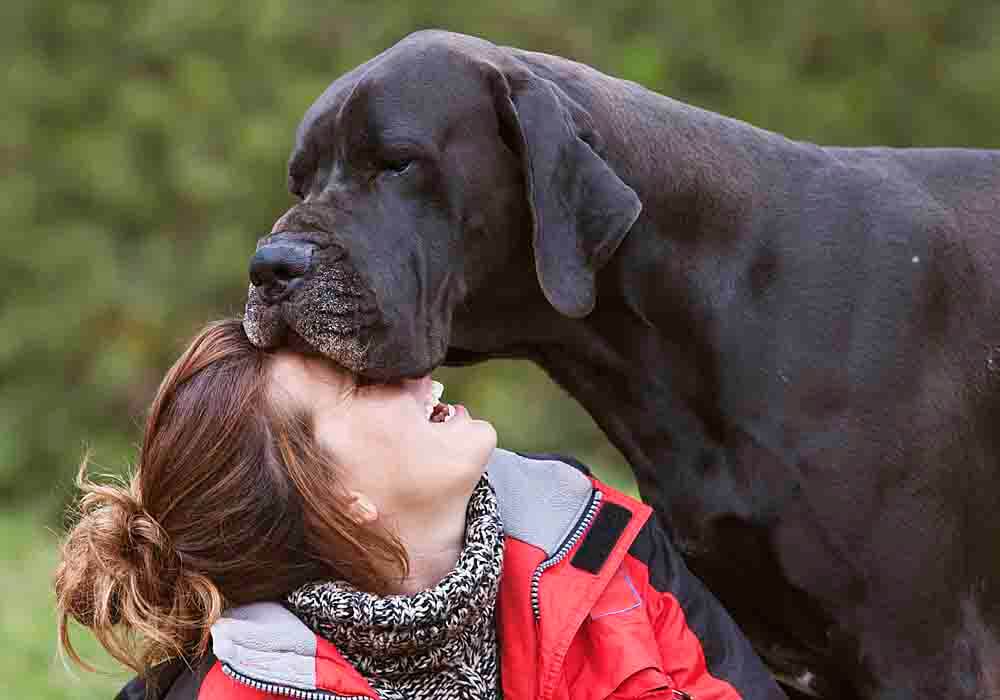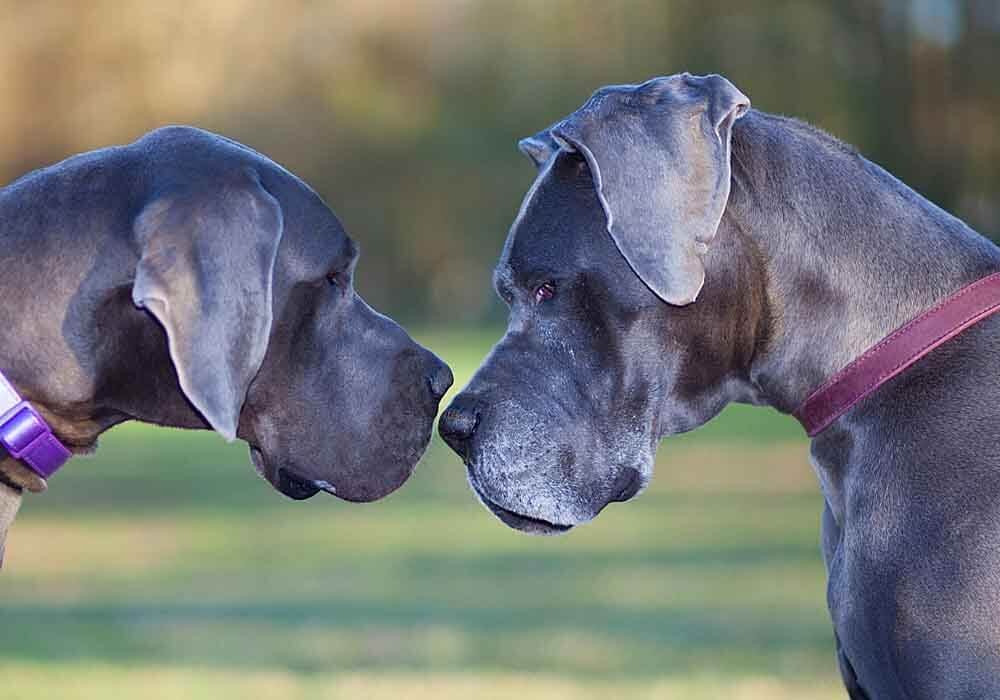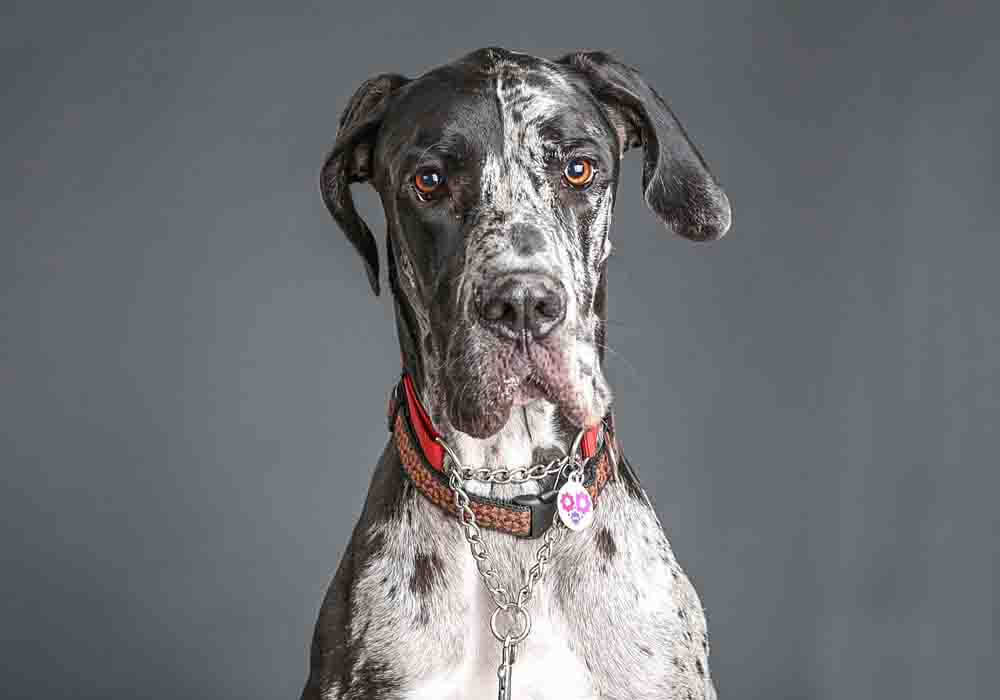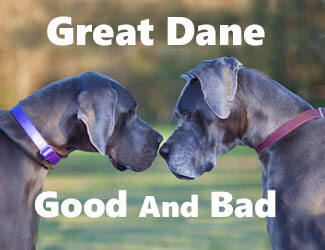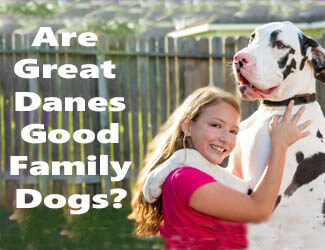Great Dane Temperament and Personality
Would This Breed Be A Good Match For You?
by Ken Alden
When Great Danes reached the pinnacle of their popularity—thanks in part to the major animation studios (think Scooby-Doo) and cartoon strips, this sparked greater demand for the breed as household pets. If you are considering perhaps acquiring one to join your family. You wonder, though, if their disposition will match yours.
Great Dane Temperament And Personality...What's It Like?
- They are naturally strong willed and need firm parenting
- They are gentle marshmallows that love giving and getting attention
- They sometimes are scared of things that make no sense
- They make great family dogs and get along with just about everyone
- They are laid back and always around which can be a double edged sword if you like your space
To find out more about these fascinating creatures, read on and see if you’re a good match. Read More Below...
Pro-tip: Ever try lifting a Great Dane? Their weight can hurt not only your back but their joints when they hop down from cars, sofas or even your bed. To protect your back and theirs check out the best Mastiff ramps on Amazon.com now.
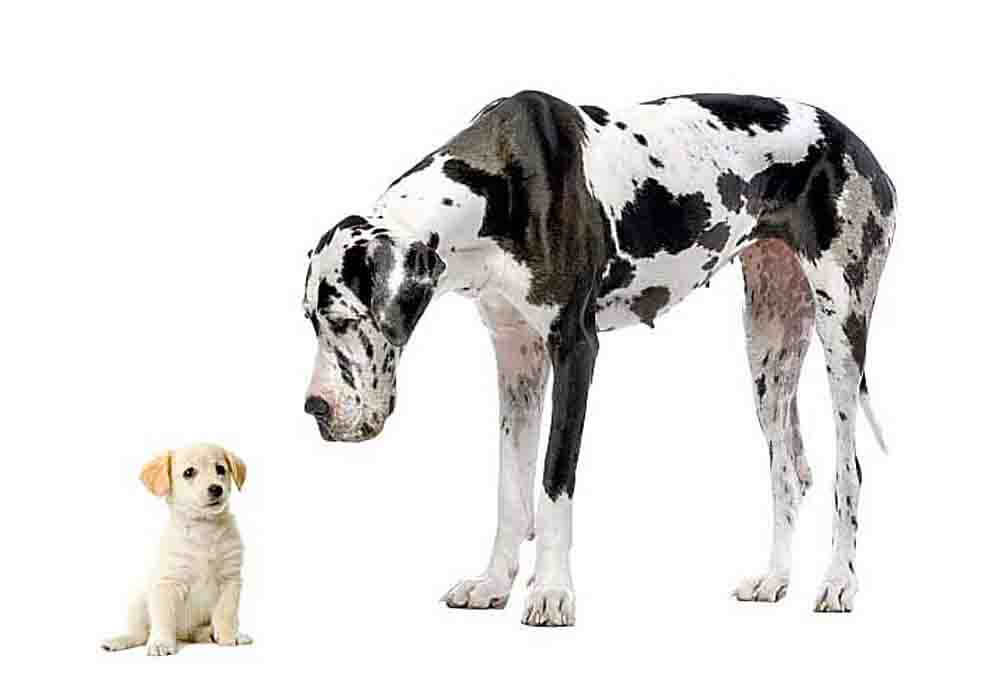
What Makes Danes Great?
Their size, literally. Great Danes (also known as German Mastiffs) are the tallest among the giant breeds. Stature aside, the American Kennel Club (AKC) ranks the Great Dane 14th most popular out of its recognized 194 breeds. Ironically, this breed’s elegant posture hides a comical trait, clumsiness.
These dogs’ blundering exploits have often been documented in cartoons. Their lumbering incoordination lives on in characters like Scooby-Doo and Marmaduke. But this klutziness is what makes Great Danes much loved and cherished.
Great Danes were originally bred to reign in deer and wild boar, so they were meant to be fast, strong, ferocious—and, of course, bigger than their quarry. Isn’t it a hoot that the breed evolved to be friendly and goofy instead? There’s more to Great Danes than meets the slobber. We’ll discuss their peculiar characteristics to help the would-be pet parent care for them. great dane temperament and personality
Great Dane Temperament
Just as physical characteristics like build and shedding frequency can be inherited, so can temperament and behavior. Good thing these two can be improved by mindful raising and proper training.
Great Danes are naturally strong-willed. While many of them are eager to please, some are obstinate and will test timid parents. Therefore, you have to be more forceful than they are. While they’re young, teach them to respect you while boosting their confidence at the same time through positive reinforcement. Socialize them early. All this preparation helps instill a stable temperament. In all instances, be consistent.
Great Dane Personality
Despite belonging to one of the largest dog breeds, Great Danes’ stern appearance belies their inner mushiness. Their valued characteristics include friendliness, docility, gentleness, devotedness, confidence, calm demeanor (in adulthood), and adoring nature. They are cherished for their sprightliness and effortless companionship.
Great Danes enjoy frolicking with fellow animals but also delight in mingling with people. They possess an intimate bond with their human parents and are protective of their families and homes.
great dane temperament and personality
Great Dane Qualities That May or May Not Be Appreciated
- They’re great with kids—but older ones. They can accidentally harm babies and toddlers because of the sheer size of their bodies. As they have very little control over their tails, these can be deadly too. Their tails are slightly less dangerous than those of stingrays (due to lack of spikes) but should nonetheless be taken into account.
- They’re laid-back and enjoy leisurely activities with their human families. This has a double-edged effect. Their perpetual need for company and attention can be overwhelming to harried parents of multiple children or busy executives. Would-be pet parents must accept this reality from the beginning and should have measures in place, such as regular and reliable pet-sitters, before acquiring their wards.
- Their size attracts attention from everyone, including unsavory folk. This important fact is often overlooked. Potential parents of Great Danes, especially introverts, should consider this seriously because walks in the park will never be the same again.
- Great Dane owners tend to be people-persons who revel in the attention their wards attract. If you’re not the friendly type, are averse to daily small talk with strangers, and don’t like being the center of scrutiny, perhaps you will be better off with a different breed, as welcoming Great Danes into your sedate home will tremendously impact your lifestyle. Great Dane temperament and personality
- Great Danes love car rides. So do other dogs, but many Danes will manipulate you into taking them with you. Potential Dane parents who own bikes, motorcycles, Beetles, or Minis should consider switching to a family van or SUV. If you can’t afford the change, or this move violates your commitment to reducing your carbon footprint, reconsider your choice of dog breed.
- Great Danes are normally mellow. But they can be dominant and bossy. This is why many Great Dane human parents are either tall or have burly physiques coupled with strong personalities. (Keeping in mind some Type A individuals are small in stature with a fragile countenance.) Unassertive people, however, may find that these big dogs, if given the opportunity, will lord it over them.
- Big-boned Great Danes find it uncomfortable lying on hard surfaces. This is why they need spacious, soft bedding and pillows. Anything that cushions their bone and joint framework isn’t just appreciated but also essential for optimum musculoskeletal health. So, factor in space requirements and sleeping arrangements prior to Dane ownership.
Pro-tip: Great Dane anxiety, aggression, destructive chewing, jumping up, fearfulness, and other behaviors can be controlled with the right training program.
Here’s a great course that
addresses these issues along with many other dog training basics: Check it out now!
How to Curb Great Danes’ Negative Traits
If you prefer puppies, you won’t be able to determine their inherited medical conditions and temperament until they reach adulthood. So it’s imperative to select puppies from a reputable breeder.
You can curb their undesirable traits through early conditioning, targeted socialization and discipline inculcation from a young age, and persistent instruction. If you want to dispense with these, select adult dogs from a registered adoption agency, rescue organization, or canine shelter. Adults manifest their characteristics readily, so you don’t have to guess or wait around for these to show up, unlike if you adopt puppies.
How to Temper Great Dane Unruliness
Undisciplined Great Danes can be a handful, not to mention dangerous, considering their immense size. They also have a stubborn streak that needs to be checked. Their rambunctiousness, though charming at first, can be irritating and hazardous. This is why obedience training at an early age is very important.
Training isn’t just for restraining exuberance. Other important reasons include suppression of the negative aspects of their temperament, behavior modification, re-education, emotional healing, and preparation for service as therapy aides or guard dogs. Note that Great Danes are also quite sensitive, so they must be handled with kid gloves and cheery disposition. Abrasive methods turn them off and make them wary of the trainer.
What Are Great Danes’ Quirks?
Future Great Dane parents should accept the fact that their babies drool and fart with a foul smell. Not just during infancy, but throughout their lives. This is part of their biology, such as possessing lengthy digestive tracts.
So, neat freaks and those who value immaculate homes over adorable messiness aren’t good candidates for Great Dane parenthood. Those who are okay with this, prepare to permanently have towels throughout the house for quick wipes and masks for the inevitable stink bombs. great dane temperament and personality
Another idiosyncrasy is their fear of rain (except their cousins from the Pacific Northwest and other wetter regions). This is ironic, considering the incessant thirst specific to Danes. (They drink copious amounts of water regardless of their geographic location.)
What Are Great Dane Puppies Like?
Puppies up to three years of age can be extremely vigorous in their enthusiasm, so it’s important to keep tabs on them at all times. Otherwise, they can be quite destructive. They undergo lightning-fast growth spurts, so they need specific care, especially in bone development and emotional support. The latter is necessary for pups to feel secure in their journey into adulthood.
Their exercise regimens should be closely monitored. Excessive physical activity at a young age can lead to joint and bone medical conditions later in life. Strenuous exercise in adult dogs, such as hiking and running, can contribute to issues like bloating. Vets, therefore, recommend moderate activities instead, such as relaxing strolls.
Decreasing exercise volume means pent-up energy, which can lead to disorderly behavior. They can go through your home like a whirlwind, inadvertently clobbering small children and objects and mangling furniture. As they are taller than most pets, they can easily jump onto tables and kitchen counters, so don’t leave food out. Temper this irrepressible energy by spending more quality time with them and supervise all their activities.

Want to learn more about Great Dane puppies and their personalities? Then check out this article of ours.
How Are Great Danes With Cats and Other Dogs?
Great Danes are normally gentle creatures that get along well with humans, fellow dogs, and other pets, especially if raised with them. This is why lots of videos show Great Danes hanging out with smaller animals like rabbits and guinea pigs.
Many Great Danes like everyone. Yet, some don’t mix well with dogs they don’t know. Some are pushy and domineering, both with other pets and humans, if they can get away with it. (This is especially true with pet parents who have a tendency to spoil their dogs and/or play favorites.) Some act aloof. Others are highly strung and get crabby at the slightest provocation (often unintentional, by children or other pets).
A few Great Danes mix well with cats if they grew up with them or are used to living in close quarters. Many, however, treat cats with aggression due to an innate instinct to chase after fast-moving animals. Still, Great Dane parents may be able to harness the breed’s natural gentleness and encourage their pets to be more chummy with cats. This can be done through socialization.
Can Great Danes Be Vicious?
Many of them can be friends with other pets, but some are hostile toward other canines of the same gender. Others are distrustful of strangers. Most are protective of their human families and can be aggressive toward people or animals they think are a threat.
This is why thorough socialization from infancy is essential. Your pets need to distinguish between friendly visitors and unwelcome intruders, as well as be able to differentiate normal actions from questionable ones.
Otherwise, they will treat everyone with mistrust, which can pave the way for hostility or fearfulness, neither of which are safe for this huge dog to cultivate. Apprehensive Danes, when feeling trapped, can bite to defend themselves.
Pro-tip: Great Dane's (and their owners) love dog crates…and for good reasons. Crates keep dogs from mischief while you're away, are perfect for house training, for traveling by car, and provide the dog a place to de-stress. Check out the best Mastiff crates on Amazon.com now.
Do Great Danes Make Good Guard Dogs?
Despite their humongous size, Danes behave more like little dogs. But no need to tell anyone that. The advantage of having spirited behemoths roaming your property is the perception of safety (albeit imagined). The fact that they’re more gentle, lumbering giants than savage attackers is immaterial. One look at them will stop intruders in their tracks. great dane temperament and personality
Their thunderous, threatening growls and barks also act as auditory deterrents. Individuals, however, vary in their natural tendencies to guard and protect. Some are not as territorial as others. Most are too easygoing to be guardians.
Do Great Danes Attack Intruders?
They appear scary mostly because of their stature and voice, but they tend to be loungers rather than security guards. As they are far from combative, it is rare for Danes to assault intruders unless provoked. They’ll often just bark to express their grievance.
Do Great Danes Make Good Service or Therapy Dogs?
Definitely. Their smartness, huggable character, and amiable qualities make them excellent service dogs. As Great Danes don’t need much exercise, mobility-impaired and/or vision-challenged owners will find caring for them manageable. Danes have the added advantage of height, enabling them to do specific activities of which smaller dogs aren’t capable.
With proper training reinforced by a well-mannered temperament, Danes make efficient therapy dogs and wonderful companions.
Do Great Danes Make Good Family Pets?
Their good-naturedness, carefree manner, docile countenance, and affectionate nature make Danes fantastic family pets. They are naturally friendly and playful toward fellow dogs, other pets, and children. Their over-enthusiasm may terrify younger kids, however. Nevertheless, well-trained, well-bred Danes are sure to flourish in most households.

Learn more about Great Danes before bringing one home. Our article Do Great Danes Make Good Family Dogs? will fill in any knowledge gap you might have.
How Do Great Danes Show Affection?
They express fondness and endearment for their owners by leaning on them. This may also be a gesture to stave off loneliness and a way of keeping their human parents close. Most Danes are oblivious to their weight and size, so when they lean, leap, or wag their tails, any item, plant, fellow pet, or a tiny kid in their immediate vicinity can be a casualty. That’s why this habit should be monitored, as with playtime with younger children and other pets. Great Dane temperament and personality
Can Great Danes Be Left Alone?
Do not leave them alone for lengthy periods. Studies have shown this is detrimental to their mental and emotional health. Danes need constant company, being inherently social as a breed. Solitude bores and stresses them, leading them to act out, such as exhibiting restlessness or destructive behavior or not eating.
The Great Dane also belongs to the category of dog breed that tends to get attached to a single
person. This behavior should be watched closely, as it can lead to
psychological conditions like separation anxiety.
How Much Attention Do Great Danes Need?
Danes require special attention at mealtimes. They consume more food than most breeds. They need a lot of hydration, so water bowls have to be filled constantly. (This means they pee more frequently than other breeds.) They also drool the most after feeding and drinking, so prep your towels and mops.
In terms of physical affection, Danes need lots of cuddling, hugging, stroking, and tummy rubs. They love napping and resting their heads on laps, nestling into nooks (like the insides of elbows and the backs of knees), and warming people’s feet.
How Much Physical Activity Do Great Danes Need?
Great Danes need more space than exercise. This is why they are more suited to houses with yards, garages, or gardens. Or big apartments with spacious balconies.
Danes tend to be couch potatoes, so they require an adequate balance of physical activity (walks, stretches) and exercise. The younger ones need to exercise 1.5 hours per day to support ligament, bone, and joint development. Adults need half an hour to an hour of exercise daily for weight management. Regardless of age, regulate their activity according to energy level.
Caveat
Apart from Great Danes’ short life spans, health issues, and upkeep expenses, potential buyers should be aware of the legal liabilities of owning them. Some regions unfairly target this breed when rejecting home insurance applications, issuing breed bans, and launching lawsuits based on their enormous size, menacing appearance, and history as hunting dogs. great dane temperament and personality
Great Dane Temperament And Personality...Conclusion
Whether you’re getting a mixed breed or a purebred, what’s important is ensuring your Great Dane has the correct food type and proper nutrition, applicable medical support, adequate training, and sufficient socialization.
Have your home ready and rally the rest of your family in welcoming your latest addition. Adequate preparation makes for a healthy, content, and cheerful dog.
Return to the top of this Great Dane Temperament And Personality page

About the Author...
Ken Alden, a dedicated Mastiff owner for over eight years, is acclaimed for his expertise in care, grooming, and training. Read more About Me and my dog Shadow.
- Mastiff Guide Home ›
- Great Danes ›
- Great Dane Temperament And Personality

